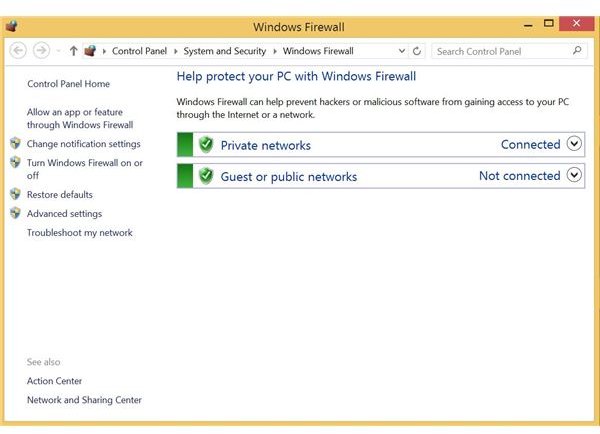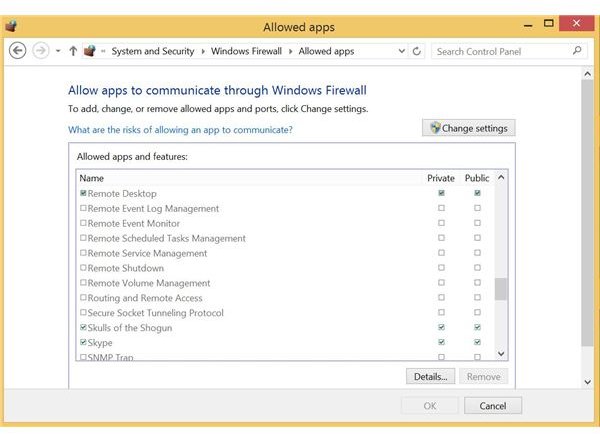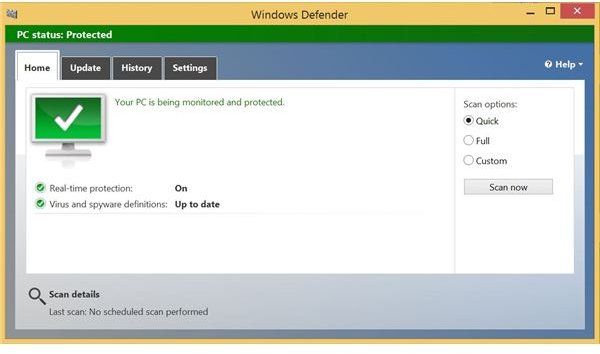Windows 8: Built-In Security Features
Windows Defender
Although Windows Defender has been around for quite a while, Windows 8 (and 8.1) include it as a default installed application. Windows Defender acts as a line of defense for viruses, spyware and other types of malware.
You can start Defender by going to the Charms bar and searching for “defender.” Note, if your computer came with a different antivirus package installed, you won’t be able to use Defender. If you haven’t paid for a third-party product yet, you may want to consider using Defender, as it is free!
Once you open Defender (Figure 1), you will see whether or not your computer is currently protected. You can run a scan from this screen or click a tab along the top to view updates, scan history and settings.
Be sure that “Real-Time Protection” is turned on to ensure malware is caught before being installed. You can verify this setting by going to the Settings tab. Exceptions can also be created under the Settings tab so if there is a folder or application you wish to exclude from scans you can set it up here.
SmartScreen Filter
The SmartScreen filter is included as part of Internet Explorer 11 – installed by default on Windows 8/8.1 computers. SmartScreen protects your browsing session in three ways:
- SmartScreen will block you from visiting known malicious websites.
- SmartScreen will block downloads of known malicious software. It will also warn you if you are downloading something that not many other people have downloaded.
- SmartScreen will warn you about suspicious web sites. You’ll have the option to go around the warning, but at least you’ll be given fair warning that something isn’t quite right.
Although SmartScreen can be turned off completely, Internet Explorer can certainly use a boost to its security reputation so I’d leave it on.
Images


Windows Firewall
Just as you wouldn’t leave your windows and doors open when you leave the house, you shouldn’t leave your computer wide open to the internet. By default, the Windows Firewall will be turned on in a new Windows 8 installation. The firewall blocks access from the internet into your computer. You’ll still be able to go from your computer out to the internet, but not the other way around. Windows XP machines were notoriously insecure – so much so that without a firewall in place, a newly installed XP machine (unpatched) could be compromised in 5-10 minutes. The firewall blocks those incoming attacks or traffic to keep your machine safe.
You can find the Windows Firewall by using the Search Charm and searching for “firewall”. When you open it, make sure that it is enabled for any network connections you currently have active (Figure 2).
If you need to allow an application to communicate with your computer from the internet, you can enable exceptions. Just click Allow an App or Feature through Windows Firewall and select the application you want to give access to (Figure 3).
If you don’t see your application listed, you may need to go to the Advanced view. To do this, go back to the main Firewall page and click Advanced Settings. The Windows Firewall with Advanced Security window will open. (Figure 4). From here you can click on Inbound Rules -> New Rule to define a custom rule.
These are just a few of the security tools built in to Windows 8. It’s nice that Microsoft gives you free alternatives to some of the expensive third-party security suites out there. The built in tools may not have as many bells and whistles as the third-party suites, but they do their job pretty well.
